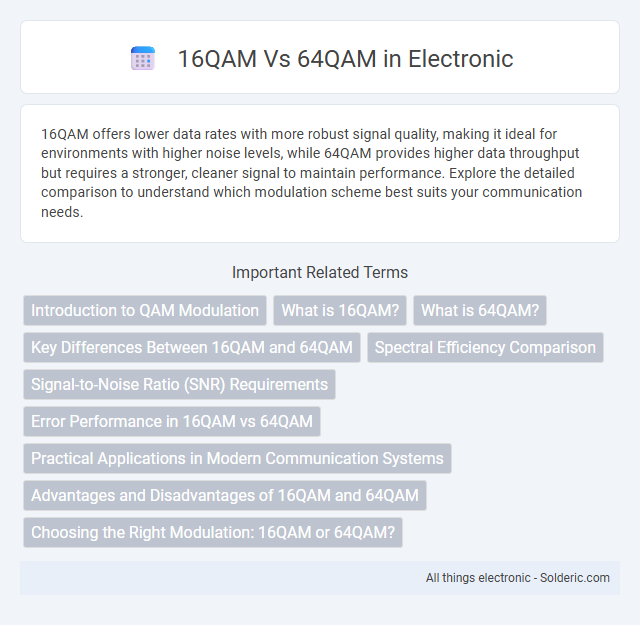16QAM offers lower data rates with more robust signal quality, making it ideal for environments with higher noise levels, while 64QAM provides higher data throughput but requires a stronger, cleaner signal to maintain performance. Explore the detailed comparison to understand which modulation scheme best suits your communication needs.
Comparison Table
| Feature | 16QAM | 64QAM |
|---|---|---|
| Bits per Symbol | 4 | 6 |
| Modulation Type | Quadrature Amplitude Modulation | Quadrature Amplitude Modulation |
| Signal Constellation Points | 16 | 64 |
| Data Rate | Lower (compared to 64QAM) | Higher (due to more bits per symbol) |
| SNR Requirement | Lower | Higher |
| Error Performance | Better in noisy channels | More susceptible to noise |
| Use Case | Reliable transmission in low SNR environments | High throughput in high SNR environments |
Introduction to QAM Modulation
Quadrature Amplitude Modulation (QAM) is a digital modulation technique that conveys data by changing both the amplitude and phase of a carrier signal. 16QAM uses 16 distinct symbols, combining four amplitude levels and four phase shifts to encode 4 bits per symbol, offering a balance between data rate and noise resistance. In contrast, 64QAM employs 64 symbols with eight amplitude levels and eight phase shifts, encoding 6 bits per symbol, which increases spectral efficiency but requires higher signal-to-noise ratios for reliable transmission.
What is 16QAM?
16QAM (16 Quadrature Amplitude Modulation) is a modulation scheme that conveys data by changing the amplitude of two carrier waves, which are out of phase by 90 degrees, combining both amplitude and phase modulation to encode 16 unique symbols. Each symbol represents 4 bits, allowing 16QAM to transmit data efficiently with moderate robustness to noise, making it suitable for wireless communication and digital broadcasting. Compared to 64QAM, 16QAM offers lower data rates but improved error performance under noisy conditions.
What is 64QAM?
64QAM (64 Quadrature Amplitude Modulation) is a digital modulation scheme that transmits data by varying both the amplitude and phase of a carrier signal, encoding 6 bits per symbol. Compared to 16QAM, which encodes 4 bits per symbol, 64QAM increases spectral efficiency by allowing higher data rates within the same bandwidth. This higher modulation order requires better signal-to-noise ratio (SNR) and is commonly used in modern wireless communication systems like LTE and Wi-Fi to enhance throughput.
Key Differences Between 16QAM and 64QAM
16QAM transmits 4 bits per symbol, while 64QAM transmits 6 bits per symbol, offering higher data rates but requiring better signal quality for accurate demodulation. The increased constellation points in 64QAM lead to greater spectral efficiency but also higher susceptibility to noise and interference compared to 16QAM. Modulation choices between 16QAM and 64QAM depend on channel conditions, balancing throughput and robustness in wireless communication systems.
Spectral Efficiency Comparison
16QAM offers moderate spectral efficiency by encoding 4 bits per symbol, allowing reliable data transmission under lower signal-to-noise ratio (SNR) conditions. In contrast, 64QAM significantly improves spectral efficiency by encoding 6 bits per symbol, enabling higher data rates within the same bandwidth but requiring a stronger SNR for accurate decoding. Your choice between 16QAM and 64QAM depends on the trade-off between data rate demands and channel quality in your communication system.
Signal-to-Noise Ratio (SNR) Requirements
16QAM requires a lower Signal-to-Noise Ratio (SNR) compared to 64QAM, making it more robust in noisy or weak signal environments. While 64QAM supports higher data rates by encoding more bits per symbol, it demands a significantly higher SNR to maintain reliable communication and avoid errors. Your choice between 16QAM and 64QAM should depend on the channel quality and the trade-off between throughput and error resilience.
Error Performance in 16QAM vs 64QAM
16QAM offers better error performance compared to 64QAM due to its lower symbol density, which results in greater Euclidean distance between constellation points and reduces the likelihood of symbol misinterpretation in noisy environments. However, 64QAM provides higher data rates at the expense of increased susceptibility to noise and interference, leading to a higher bit error rate (BER). Your choice between 16QAM and 64QAM depends on the trade-off between data throughput and the required robustness against transmission errors.
Practical Applications in Modern Communication Systems
16QAM is widely used in wireless networks like LTE and Wi-Fi for moderate data rates with robust signal quality in environments with higher noise levels. 64QAM offers higher spectral efficiency, making it suitable for high-throughput applications such as 5G NR and advanced cable modem systems where conditions support stronger signal-to-noise ratios. Modern communication systems dynamically switch between 16QAM and 64QAM modulation schemes based on channel quality to optimize data rates and reliability.
Advantages and Disadvantages of 16QAM and 64QAM
16QAM offers lower complexity and better noise resilience, making it suitable for environments with weaker signal strength or higher interference, but it provides lower data rates compared to 64QAM. In contrast, 64QAM enhances spectral efficiency with higher data throughput, ideal for strong signal conditions, yet it requires higher signal-to-noise ratios and is more prone to errors in noisy environments. The choice between 16QAM and 64QAM depends on the trade-off between data rate demands and channel quality constraints in wireless communication systems.
Choosing the Right Modulation: 16QAM or 64QAM?
Choosing between 16QAM and 64QAM modulation depends on the trade-off between data rate and signal robustness; 16QAM offers greater noise immunity and better performance in low signal-to-noise ratio (SNR) environments, making it suitable for stable, long-range communication. In contrast, 64QAM provides higher spectral efficiency and increased data throughput at the cost of requiring higher SNR and being more susceptible to signal degradation, ideal for high-capacity, short-distance links. Network designers must evaluate channel conditions, desired data rates, and error tolerance to optimize modulation scheme selection for wireless and wired communication systems.
16QAM vs 64QAM Infographic

 solderic.com
solderic.com